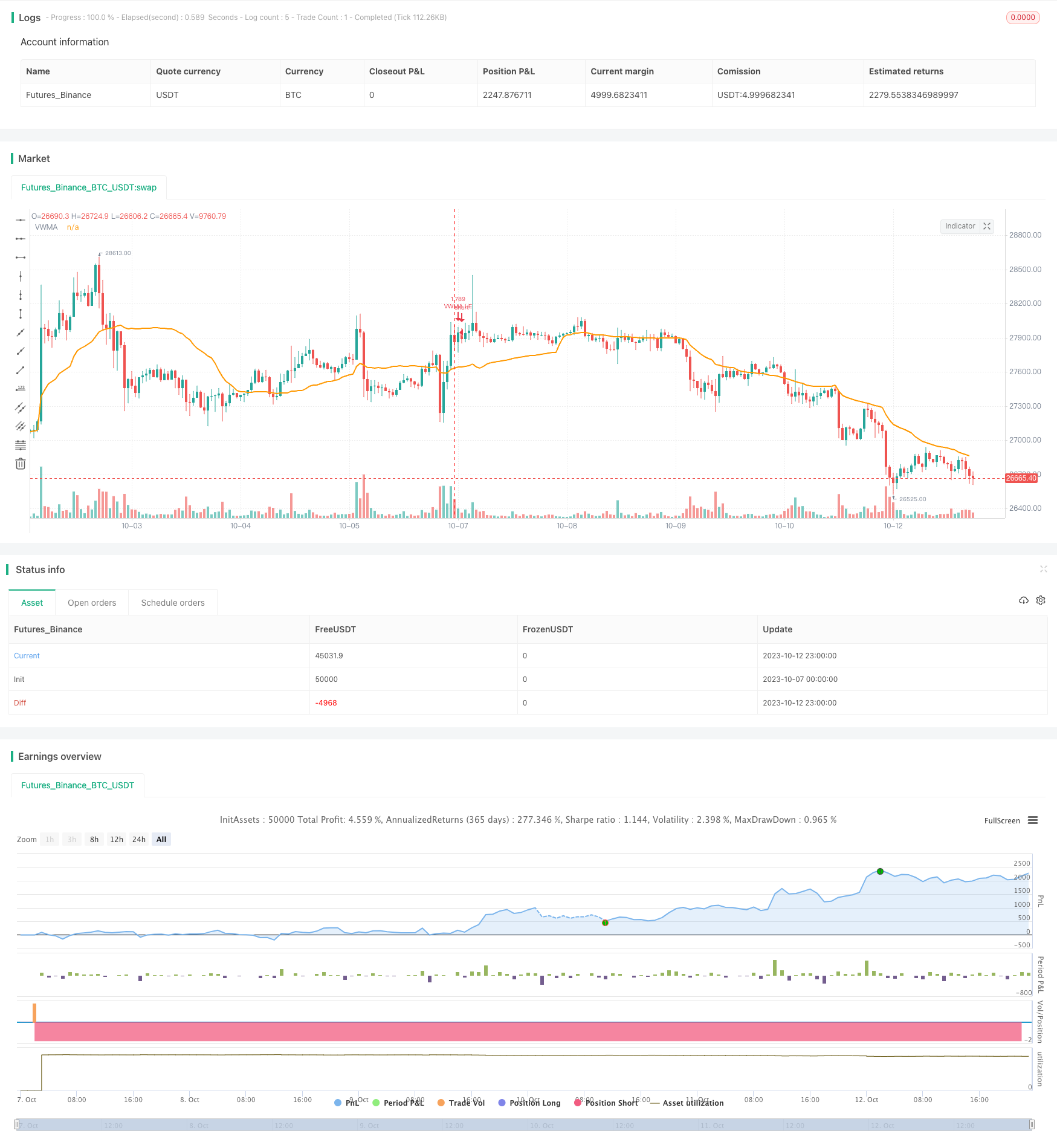
概述
该策略采用VWMA指标判断趋势方向,并使用ATR指标设定止损线实现趋势跟踪。策略适用于具有明显趋势的市场环境。
策略原理
使用VWMA指标判断趋势方向。当价格高于VWMA时判断为上升趋势,做多;当价格低于VWMA时判断为下降趋势,做空。
为过滤假突破,加入RSI oscillator判断。只有当RSI高于30时才会发出做多信号。
使用ATR指标计算止损线。ATR长度设置为与VWMA相同,倍数设置为3.5。止损线会根据价格实时更新。
ATR倍数的设置会影响止损线的收缩幅度。倍数越大,止损线更新频率越低,跟踪趋势的效果较好。
根据策略内的止损百分比和账户权益计算仓位大小。
当价格跌破止损线时止损退出做多头寸。
策略优势
使用VWMA指标判断趋势方向,可以持续捕捉趋势机会。
增加RSI filter,可以过滤掉部分假突破signals。
ATR止损线实现趋势跟踪,避免被反转Stopping out。
根据账户权益和止损百分比计算仓位,有利于风险控制。
策略风险
在趋势转折点存在亏损风险。应适当缩小仓位,降低单笔亏损。
ATR参数设置不当,会导致止损线过于敏感或迟钝。应测试确定合适的参数。
如果趋势反转过快,止损线更新可能来不及,会扩大亏损。
在低波动市场中,应降低仓位并增加止损线收缩频率。
优化方向
可以测试不同的VWMA参数组合,选择产生signal最佳的参数。
可以测试RSI oscillator的其他参数设定,如超买超卖线等。
可以测试ATR的倍数参数,找到在回撤和跟踪之间做tradeoff的最佳点。
可以结合其他指标过滤signal,例如MACD,KD等,提高信号质量。
可以根据市场波动情况优化仓位管理和止损百分比。
总结
该策略整体偏趋势,适合用来捕捉明显的价格趋势。策略具有趋势判断、信号过滤、止损跟踪等方面的优势,也存在趋势反转风险。通过优化参数设定和仓位管理,可以获得更好的策略效果。
/*backtest
start: 2023-10-07 00:00:00
end: 2023-10-13 00:00:00
period: 1h
basePeriod: 15m
exchanges: [{"eid":"Futures_Binance","currency":"BTC_USDT"}]
*/
// This source code is subject to the terms of the Mozilla Public License 2.0 at https://mozilla.org/MPL/2.0/
// © mohanee
//@version=4
//strategy("", overlay=true)
strategy(title="VWMA_withATRstops_strategy V2", overlay=true, pyramiding=1, default_qty_type=strategy.percent_of_equity, default_qty_value=20, initial_capital=10000, currency=currency.USD) //default_qty_value=10, default_qty_type=strategy.fixed,
float xATRTrailingStop=na
int pos=na
vwmalength = input(33, title="VWMA Length", minval=1, maxval=365)
//vwmalength2 = input(9, title="VWAM Short Term Length", minval=1, maxval=365)
nATRPeriod = input(33, title="ATR length", minval=1, maxval=365)
nATRMultip = input(3.5, title="ATR Multiplier")
rsiofVwmaLength=input(14, title="RSI of VWMA Length")
riskCapital = input(title="Risk % of capital", defval=10, minval=1)
stopLoss=input(5,title="Stop Loss",minval=1)
vwmaVal=vwma(close, vwmalength)
//vwmaVal2=vwma(close, vwmalength2)
//maVal=sma(close, vwmalength)
plot(vwmaVal, color=color.orange, linewidth=2, title="VWMA")
//plot(vwmaVal2, color=color.blue, title="VWMA Short Term")
//plot(maVal, color=color.blue, title="MA")
//rsi of vwma Longterm
rsiofVwmaVal=rsi(vwmaVal,rsiofVwmaLength)
xATR = atr(nATRPeriod)
nLoss = nATRMultip * xATR
xATRTrailingStop:= iff(close > nz(xATRTrailingStop[1], 0) and close[1] > nz(xATRTrailingStop[1], 0), max(nz(xATRTrailingStop[1]), close - nLoss), iff(close < nz(xATRTrailingStop[1], 0) and close[1] < nz(xATRTrailingStop[1], 0), min(nz(xATRTrailingStop[1]), close + nLoss), iff(close > nz(xATRTrailingStop[1], 0), close - nLoss, close + nLoss)))
pos:= iff(close[1] < nz(xATRTrailingStop[1], 0) and close > nz(xATRTrailingStop[1], 0), 1, iff(close[1] > nz(xATRTrailingStop[1], 0) and close < nz(xATRTrailingStop[1], 0), -1, nz(pos[1], 0)))
color1 = pos == -1 ? color.red: pos == 1 ? color.green : color.blue
//plot(xATRTrailingStop, color=color1, title="ATR Trailing Stop")
//Entry--
//Echeck how many units can be purchased based on risk manage ment and stop loss
qty1 = (strategy.equity * riskCapital / 100 ) / (close*stopLoss/100)
//check if cash is sufficient to buy qty1 , if capital not available use the available capital only
qty1:= (qty1 * close >= strategy.equity ) ? (strategy.equity / close) : qty1
//Long Entry
//strategy.entry(id="VWMA LE", long=true, qty=qty1, when= close >vwmaVal and open>vwmaVal and close>open and close > xATRTrailingStop and xATRTrailingStop> vwmaVal)
strategy.entry(id="VWMA LE", long=true, qty=qty1, when= rsiofVwmaVal>=30 and close>open and close>vwmaVal and pos == 1 ) ///pos == 1 means ATRStop line is green
//vwmaVal2>vwmaVal and
plot(strategy.position_size>=1 ? xATRTrailingStop : na, color=color1, style=plot.style_linebr, title="ATR Trailing Stop")
bgcolor(strategy.position_size>=1 ? color.blue : na )
//Exit
strategy.close(id="VWMA LE", when= strategy.position_size>=1 and crossunder(close, xATRTrailingStop) )
//strategy.close(id="VWMA LE", when= strategy.position_size>=1 and close<vwmaVal and open<vwmaVal and close<open )